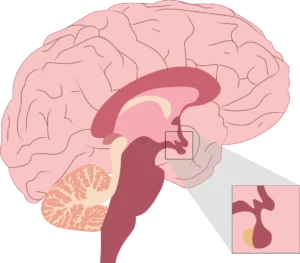
What is acromegaly?
Acromegaly is a rare condition in which the body makes too much growth hormone. This is usually caused by a non-cancerous tumour at the base of the brain, in a small pea sized structure called the pituitary gland:1

Pituitary Gland
Sex:
Approximately
50% women
50% men2
Median age at diagnosis:
Fifth decade
of life3
Worldwide prevalence:*
per 100,000
persons4
*‘Prevalence’ is the proportion of people who have a condition at any given time.

Gradual onset
Men and women are equally likely to have acromegaly2 and people tend to be diagnosed in their mid 40s.3 However, they may have had the condition for several years before being diagnosed, as symptoms develop gradually5 and, when considered individually, can be associated with many other diseases.

Effects of growth hormone
The production and release of growth hormone by the pituitary gland is a normal biological process. We need growth hormone to keep our bones and muscle strong, as well as helping with things like managing our energy processes. The problem is, having too much growth hormone causes abnormal growth of bones and soft tissues such as muscles. Energy levels can be affected too, leaving people with acromegaly feeling weaker and more tired than usual.6

Health impact
Acromegaly can make life harder by changing how a person looks, affecting their health, and possibly shortening how long they live.6-9 Taking control with effective treatment improves physical health and restores life expectancy to normal.6,11
References
1. Chanson P, Salenave S. Orphanet J Rare Dis 2008;3:17.
2. Dal J, et al. Clinical Endocrinology (Oxf) 2021; 94(4):625–635.
3. Lavrentaki A, Paluzzi A, et al. Pituitary 2017; 20:4-9.
4. Crisafulli S, et al. Eur J Endocrinol 2021 Jul 1;185(2):251-263.
5. Fleseriu M, et al. Lancet Diabetes Endocrinol 2022; 10(11):804–826.
6. Coopmans E, et al. Endocrinol Metab Clin N Am 2022;51:709–25.
7. Colao A, et al. Nat Rev Dis Primers 2019;5:20.
8. Geer EB, et al. BMC Endocr Disord 2020;20:117.
9. Yedinak C, et al. Clin Pract 2018;15: 499–511.
10. Bolfi F, et al. Eur J Endocrinol 2018;179:59–71.
11. Gadelha MR, et al. Endocr Rev 2019;40:268–332.
9. Geer EB, et al. BMC Endocr Disord 2020;20:117.
10. Yedinak C, et al. Clin Pract 2018;15: 499–511.
11. Bolfi F, et al. Eur J Endocrinol 2018;179:59–71.
